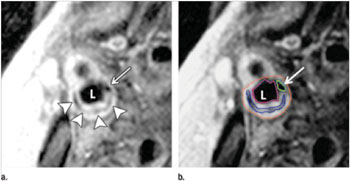Carotid Artery MRI May Predict Probability of Heart Attack, Stroke
By HospiMedica International staff writers
Posted on 17 Mar 2014
Noninvasive magnetic resonance imaging (MRI) of carotid artery plaque can effectively forecast future cardiovascular events such as strokes and heart attacks in individuals without a history of cardiovascular disease, according to a new research.Posted on 17 Mar 2014
Researchers have long known that some arterial plaque is more dangerous because of its vulnerability to rupture. MRI can distinguish facets of vulnerable plaque, such as a lipid core with a thin fibrous cap. This ability makes MRI a potentially valuable tool for identifying patients at risk for ensuing cardiovascular events.
To study the predictive benefits of MRI plaque imaging, researchers performed carotid artery ultrasound and MRI on 946 asymptomatic patients from the Multi-Ethnic Study of Atherosclerosis (MESA). The carotid arteries are very accessible for imaging, and their condition tends to reflect that of the coronary arteries that supply the heart with oxygenated blood.
The researchers, who published their findings online March 2014 in the journal Radiology, used ultrasound to evaluate carotid wall thickness and MRI to define carotid plaque composition and the remodeling index, a gauge of changes in vessel size. Imaging findings were compared with cardiovascular events, including heart attacks, stroke, and death, for an average of 5.5 years after examination.
“We studied asymptomatic individuals with a low risk of cardiovascular events at baseline and used noninvasive imaging to predict the risk of an event downstream,” said David A. Bluemke, MD, PhD, from the US National Institutes of Health Clinical Center (Bethesda, MD, USA). “This is the first population-based prospective study to determine if vulnerable plaque features by MRI add to the risk of a cardiovascular event beyond the traditional risk factors.”
Cardiovascular events occurred in 59 of the patients. Abnormal thickening of the carotid artery wall and the presence of a lipid core and calcium in the internal carotid artery on MRI were significant predictors of subsequent events. A lipid core was present in nearly half of the patients who had an event, compared with only 17.8% of those who did not have an event. “The primary factors that predicted future risk were measures of vessel wall thickness in combination with the presence or absence of a lipid core,” Dr. Bluemke said. “The presence of a lipid core was 50% more common in people who had subsequent events.”
Using MRI scanning improved the reclassification of baseline cardiovascular risk in the study group. When both the carotid remodeling index and lipid core were used for risk stratification, approximately 16% more patients with events and 7% without events were accurately reclassified compared with the use of traditional risk factors. “The results bolster the use of MRI as a surrogate marker of efficacy in therapeutic studies and point to a role in determining which patients might need more aggressive treatments,” Dr. Bluemke said. “As risk factor prediction gets better, we’ll be able to screen more intelligently and use more intensive treatments in those individuals who face a higher risk of cardiovascular events.”
Dr. Bluemke noted that sequences for plaque composition could be readily added to existing carotid MRI angiography protocols for clinical purposes. “Carotid MRI has significant advantages,” he stated. “The results are more reproducible than those of ultrasound.”
Dr. Bluemke emphasized that the availability and cost-effectiveness could restrict the use of MRI. However, ultrasound and computed tomography (CT) are practical options for screening, he noted, particularly with improvements in CT dose reduction.
Related Links:
US National Institutes of Health Clinical Center
















